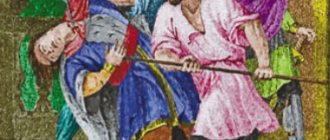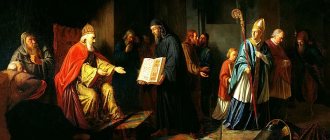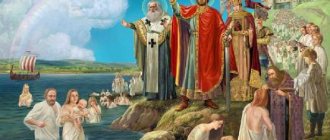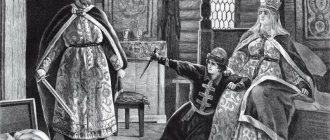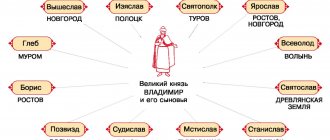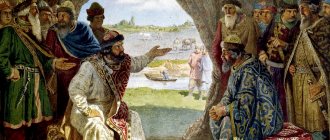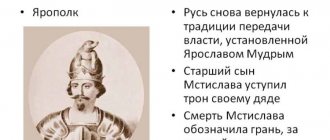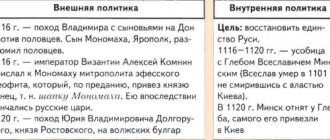Svyatopolk Vladimirovich “The Damned” (Art. V. Sheremetyev. 1867)
Svyatopolk Vladimirovich (nicknamed “The Accursed”) is the son or stepson of Prince Vladimir Svyatoslavich from an unknown “Greek woman”, who was the wife of Prince Yaropolk, and was taken as a concubine by Vladimir after the murder of his brother. Born around 979, Svyatopolk never considered himself the son of Vladimir, and after his death he seized power in Kyiv, starting the internecine war of 1015-1019 (ruled Kiev in 1015-1016 and 1018-1019). According to the generally accepted version of history, it was Svyatopolk who sent assassins to his brother princes Boris, Gleb and Svyatoslav, for which he received the nickname “Cursed” .
He fought with his brother Yaroslav for power with the help of the Polish prince Boleslav, whose daughter he was married to. After the defeat in 1019, he fled to the West, and died somewhere between the Czech Republic and Poland.[1]wikipedia
East Slavic tribes VIII-IX centuries.
The Tale of Bygone Years tells that on the eve of the unification of most East Slavic tribes under the rule of a single center - Kyiv, there were at least 14 large tribal unions:
- glades (dwellers of fields), habitat – middle Dnieper region, center – Kyiv
- Novgorod Slovenes, habitat - in the north of the glades, the northernmost tribe, centers - Novgorod, Ladoga
- Drevlyans (inhabitants of forests), habitat – north-west of the glades, center – Iskorosten
- Dregovichi (inhabitants of swamps), habitat – north of the Drevlyans (territory of modern Belarus), no large centers
- northerners, habitat - east of the glades (along the Desna, Seim, Sula rivers), center - Chernigov
- Vyatichi, habitat - in the northeast of the northerners (interfluves of the Oka, Klyazma and Volga), centers - Rostov, Suzdal
- Krivichi, habitat - between Vyatichi and glades (in the upper reaches of the Volga, Dnieper and Western Dvina), center - Smolensk
- Polotsk residents, habitat - southwest of the Krivichi (Western Dvina basin), center - Polotsk
- Radimichi, habitat - south of Krivichi, north of glades (along the Sozh and Seim rivers), no large centers
- Volynians, Buzhanians, White Croats, habitat - southwest of the glades (Bug River basin), westernmost tribes
- Ulichi, Tivertsy, habitat – south of the glades, southernmost tribes
All ancient descriptions of the settlement of the East Slavic tribes say that they did not live in isolation from their foreign-language neighbors. So, for example, in the area where the Novgorod Slovenes lived and in the vicinity of the Vyatichi and Krivichi lived Finno-Ugric tribes:
- measuring
- all
- Corela
- Chud
- Muroma
- Mordovians
Collecting tribute from surrounding tribes, some Slavs themselves were in a state of tributary dependence on stronger foreign neighbors.
The Khazars collected tribute from:
- clearing
- northerners
- Radimichi
The Varangians collected tribute from:
- Novgorod Slovenians
- Krivichi
- chudi
- Mary
Social system of the Slavs
Let's talk about how the Eastern Slavs lived and how their society was structured. It must be admitted that the amount of evidence that can shed light on the peculiarities of the social system of the Slavs is limited. Therefore, we will allow ourselves to dwell only on some more general, but reliably known theses about Slavic society.
VI - VIII centuries - the time of decomposition of the tribal system among our ancestors. Tribes are gradually being replaced by military-political formations headed by princes, while at the same time the role of both the prince himself and the warriors led by him is growing. The key function of the prince at the initial stage is exclusively military: protecting the territories under his control from external enemies. For their “work” the prince and the warriors should receive payment, because formally they could at this time cultivate the land and grow bread, since they do not do this for a good reason - the population should provide the prince and the warriors with everything necessary for life (food, clothing, housing). Therefore, the prince begins to regularly travel around the territories with subject populations and collect tribute (polyudye) from them.
At this stage, a transitional form of government to the state is being formed within Slavic society - military democracy.
Signs of military democracy:
- all members of the tribe or tribal union, of course, we are talking about men, participate in solving the urgent problems of the tribe
- the people's assembly, consisting of men, is the highest authority
- perhaps the most important feature is the general arming of the population
Thus, by the 8th century. the Slavs were already a few steps away from creating a state, that is, all the prerequisites for this were present. The only open question was which tribal union would take on the burden of the unifier and at what specific moment this would happen.
The process of state creation was accelerated thanks to:
- the fight against the military-commercial expansion of the Varangians
- aggression of the Khazar Khaganate, on which most of the East Slavic tribes were dependent
Economy of the Slavs
What was the life of the East Slavic tribal unions like on the eve of the appearance of their state? Let's first look at the list of occupations of the Eastern Slavs, or rather two tribal unions: the Polyans and the Novgorod Slovenes. The Polyans, we recall, lived in the middle Dnieper region, that is, they were actually located very well - in the very center of the East Slavic lands. The Novgorod Slovenes occupied large areas in the very north. Occupations of the glades: arable farming, cattle breeding, horse breeding, gardening, iron and pottery production. Occupations of Novgorod Slovenes: navigation, trade, crafts, fishing.
Various natural conditions and features of the geographical location dictated their conditions and determined the methods and technologies of farming for various tribes.
But when we talk about the main features of the economy of the East Slavic tribal unions, we mean, first of all, the level of development of the Middle Dnieper region, that is, we focus on the most developed tribal union - the Polyans.
Agriculture was most widely developed in the glades. Types of agricultural machinery of the Eastern Slavs: ralo (primitive plow), plow (from the 9th-10th centuries), iron sickles.
The Eastern Slavs were not only engaged in agriculture. Near their villages there were also meadows where cattle and sheep were grazed; residents raised pigs and chickens. Oxen and horses were used as draft power on the farm. They hunted elk, deer, chamois, birds, and caught fur-bearing animals.
Valuable fur was exchanged and sold, including to Byzantium. Fur became a unit of tribute for the Slavic, Baltic and Finno-Ugric tribes, and became, in fact, the equivalent of metallic money. One of the types of metal coins in Rus' was called kunami, literally martens.
The Eastern Slavs were actively involved in bee farming, collecting honey and wax and widely using them in their households.
Time passed, and a moment came when an individual family no longer needed to constantly resort to the support of the clan. The family economy began to gradually disintegrate. The clan community became a neighborhood community, where each family had the right to its share of communal property.
In such conditions, there is another round of rapid growth in the authority and power of princes and warriors, as well as those who serve the spiritual needs of this almost born state - shamans and sorcerers, priests and wise men of various stripes. This was the time of the birth of property inequality.
In the VIII-IX centuries. the famous route “from the Varangians to the Greeks” was born (see map!), which became the connecting link for all the lands of the Eastern Slavs and for several centuries the main trade artery. Along this path, large Slavic urban centers appeared like mushrooms after rain - Kyiv, Smolensk, Lyubech, Novgorod.
In addition to the “route from the Varangians to the Greeks,” there was an eastern trade route that ran along the Don and Volga.
The Eastern Slavs were at an average level in terms of the pace of their development. And if they simply lagged behind Western countries, then the Byzantine Empire and the Arab Caliphate seemed to be at some unattainable height.
The struggle for power after the death of Vladimir the Saint. Yaroslav the Wise at the head of Ancient Rus'.
In 1015, shortly before the death of Vladimir, the Novgorodians, together with Prince Yaroslav, stopped paying tribute to Kyiv. The Kiev government assessed the behavior of the Novgorodians as the first step towards separation from Kyiv.
Vladimir, firmly holding to his old positions, decided to gather an army and force Novgorod to submit to his demands with military force. Novgorodians also began to prepare for war. To strengthen their defense capability, they not only mobilized their internal forces, but also turned to the Varangians for help. The Varangian mercenary squad arrived in Novgorod, but the Novgorodians, taking advantage of the absence of Yaroslav, who was at that time on his suburban estate (the village of Rakoma), rebelled against the Varangians and killed them.
Returning to the city, Yaroslav took revenge on the Novgorodians and killed those who participated in the extermination of the Varangians. In the midst of these bloody events, Yaroslav received secret news from his sister from Kyiv that his father had died and there would be no campaign against Novgorod.
In Kyiv at that time the situation was very serious. Instead of his father, Yaroslav's brother Svyatopolk sat on the Kiev table, and began to threaten his brothers. This is the same Svyatopolk who, together with his wife, the daughter of the Polish king Boleslav, and her confessor, Bishop Rhineburn, participated in a conspiracy against his father Vladimir. As we already know, he was imprisoned, but then released. Before his father's death, he was free, but also idle, since his father, apparently, did not risk giving him instructions.
Upon receiving news from Kyiv, Yaroslav immediately sent an urgent message to warn Gleb of Murom about the danger.
Svyatopolk, nicknamed “The Accursed,” managed to kill Boris, Gleb of Murom, Svyatoslav Drevlyansky and, obviously, was preparing to do the same with Yaroslav. The chronicle says this about Svyatopolk, explaining his intentions: “... I will beat my brethren and accept Russian power alone.”
Yaroslav convened a meeting in Novgorod and outlined the state of affairs to the Novgorodians. Yaroslav asked the veche for forgiveness for the beating of the Novgorodians who participated in the massacre of the Varangians, and proposed to think together about the situation that had arisen. He forced them to seriously think about the question of what to do next: whether to follow Svyatopolk and, therefore, maintain the old relations with Kiev, that is, pay him tribute, or support him, Yaroslav, with whose name they had hopes for a political autonomy?
The Novgorodians expressed their consent. After this, Yaroslav went south with a 4,000-strong squad (the figure according to the Novgorod summer fox) along with the Pechenegs he attracted. Svyatopolk was defeated at Lyubech and fled to Poland to his father-in-law, the Polish prince Boleslav. The latter always willingly intervened in Kyiv affairs, wanting to profit at the expense of neighboring Rus', and, in particular, to return the lands conquered by Vladimir.
Yaroslav entered into an alliance with the German Emperor Henry II and went with him to Poland. Boleslav, however, managed to make peace with Henry and went with Svyatopolk to Kyiv against Yaroslav (1018). Mercenary Germans and Hungarians participated in his army, in addition, Svyatopolk attracted the Pechenegs to himself. Yaroslav went out to meet the enemies and met them at the Western Bug. Yaroslav was defeated and fled with four warriors to Novgorod. However, the Polish army did not remain in Kyiv for long. The Poles caused outrage among the population of the Kiev region; The Russian people began to beat the Poles “otai”, that is, secretly from the authorities, who, for obvious reasons, in the current situation could not take the side of the rebels. Boleslav was forced to hastily return to his home, however, capturing the Cherven cities, recently conquered from Poland by Vladimir Svyatoslavich.
According to the Novgorod legend, Yaroslav wanted to go overseas to gather the Varangian squad again, as his father did and just recently he himself, but the Novgorodians chopped up his boats, did not let him cross the sea, promised to help him themselves and really helped. An interesting fact is the active participation of the Novgorod urban masses in major political events. Although the Novgorod news does not agree with Thietmar’s data, it is quite probable.
Svyatopolk's triumph did not last long. Yaroslav and the Novgorodians defeated him and occupied Kyiv. Svyatopolk fled to the Pechenegs and together with them again went against Yaroslav. On the river Alte Yaroslav inflicted a decisive defeat on him. Svyatopolk fled to an unknown destination. After these major events, Yaroslav began to own Kiev. Now Yaroslav has become dangerous for those who sought to break away from Kyiv, including his recent like-minded people.
The Polotsk prince Bryachislav, Yaroslav’s nephew, spoke out against Yaroslav. In 1021 he attacked Novgorod and returned to his place with the booty. Yaroslav caught up with him, took the loot, but soon made peace with Bryachislav and even gave him Usvyat and Vitebsk. Although peaceful relations were established with the Prince of Polotsk from that time on, the Principality of Polotsk began to live an autonomous life, waging a long struggle with Kiev.
Another brother of his, the Tmutorokan prince Mstislav, rose up against Yaroslav, who turned out to be a very formidable and serious opponent. The winner in the fight between Kyiv and Tmutorokan. The last one turned out to be the prince. This happened in 1023 (Battle of Lietvitsa near Chernigov).
In this clash, it is important for us to emphasize the following: Mstislav defeated Yaroslav and could have taken possession of Kiev, and everything in Kyiv. state, but this did not happen, firstly, because Mstislav “did not accept the Kiyans,” and, secondly, because Mstislav was indifferent to Kyiv and did not want to fight the “Kyans,” despite the obvious superiority of his forces . Mstislav limited himself only to expanding his possessions to the Dnieper and became a ruler independent of Kyiv.
From here we have the right to draw conclusions. 1. Townspeople (kiyans) begin to speak more loudly, the political importance of townspeople is growing; The princes already have to reckon with this power. 2. Mstislav, breaking away from Kyiv, behaves as a representative of the new political order (feudal fragmentation), 3. The collapse of the Kyiv state began.
Yaroslav, in gratitude for the help, actually fulfilled his promises to the Novgorodians. The point here, of course, is not his personal honesty. He was, as we indicated, of the opinion that Novgorod should be given independence to carry out the tasks facing it.
We know that Yaroslav gave special letters to the Novgorodians, which, unfortunately, have not reached us. Novgorodians valued them throughout their entire independent history. When concluding agreements with the princes, the Novgorod Republicans demanded an oath from the princes “on all charters of Yaroslavlikh.” The Novgorodians considered them the basis of their constitution.
After the death of Mstislav of Tmutorokan (1036), Yaroslav managed to take possession of his land, and the Kiev state again became immense in size and “united”.
Slavic beliefs
The beliefs of the Slavs were initially associated mainly with agriculture. The meaning of pagan beliefs and accompanying rituals is to influence the forces of nature in the hope of getting a good harvest. Man himself was not separated from nature, being considered part of it.
In the Slavic pagan world, there were many creatures who were identified with the forces of nature; more often they tried to “appease” them, to beg them for something, less often - to scare them, but with the same goal - to achieve a better life for themselves.
Those who supposedly could control the forces of nature were called magi. It was to them that people hurried for help in case of famine, disease, or crop failure. Paganism was a polytheistic religion: the Slavs had many gods.
The god of heaven and fire was called God or Svarog and was represented in the form of a young blacksmith.
The earthly deities who could direct the destinies of people included: Lado (god of peace, spring, love); Dazhdbog (Yarilo, Khoros) - god of the sun; Stribog (god of the wind); Veles (god of trade, patron of livestock); Simargl (god of seeds and plants); Mokosh (goddess of water, fertility and motherhood); Perun (god of thunder and lightning), etc.
Along with large, so to speak, important deities, there were also small or insignificant ones, whose area of responsibility was much narrower, and whose strengths and abilities were less; as a rule, they were tied geographically to a specific place - demons, nymphs, dryads, goblins , aquatic.
Since in those distant times there were no places of public worship (temples or similar structures), usually images of gods in the form of stone or wooden figures (idols) were placed in certain open places - temples, and the sacrifices that were made to the gods were called - requirements
Over time, Perun, the god of war, thunder and lightning, the patron of the prince and his squad, becomes one of the most revered gods, which in itself is an indicator that a state will soon appear here.
Thus, at the heart of Slavic paganism are two cults: the cult of nature and the cult of ancestors. The cult of nature helped to formalize and consolidate the connection between man and nature, and the cult of ancestors contributed to the formation of family values among the Slavs.
Oath of Svarozhich. B. Olshansky.
Reign of Rurik, Oleg, Igor, Olga
Prince Rurik (reigned 862-879)
Rurik was called to Rus', according to the Tale of Bygone Years, in 862. He came not alone, but with his brothers Sineus and Truvor. Having come to Rus', Rurik sat down to reign in Novgorod, Sineus - in Beloozero, Truvor - in Izborsk. It was Rurik who became the founder of the Rurik dynasty, which would rule in Rus', and then in Russia until 1598.
Some modern researchers are inclined to believe that the story of Rurik and his brothers is nothing more than a later insertion into the chronicle, due solely to political reasons. The other part gives Rurik the right to exist, but believes that Sineus and Truvor are certainly fictional figures.
Within the framework of our historical narrative, we allow ourselves to consider Rurik a real historical figure, about whom we know several facts regarding the accession of the first tribes to the newborn state: in 883 - the Drevlyans, in 884 - the Northerners, in 885 - the Radimichi.
Around the same time in 862, Askold and Dir, who were probably Rurik’s warriors, were heading to Constantinople with ambitious plans - neither more nor less, but to establish control over the route “from the Varangians to the Greeks”, literally stumbled upon Kyiv and, as if by chance establish their power there.
Further about Rurik we know that in 879 he dies in Novgorod, leaving his young son Igor in the care of the regent Oleg, who was either a relative, or a warrior, or simply a close friend of Rurik.
Uprising in Novgorod
Soon the situation in Novgorod began to heat up. A huge mass of mercenaries stood idle in one of the richest cities of the North - it is clear that the temptation naturally arose to take compensation from the local population for their stay. Chroniclers spoke of cases of rape of married women and repeated acts of robbery. For some time the Novgorodians tolerated this. Troops were needed for the war against Kyiv. However, their patience soon came to an end.
Vikings Source: norse.ru
One night, the bravest Novgorodians made their way into the area where foreign mercenaries lived - Poromonov Dvor - and carried out a real massacre. Hundreds of guests from overseas died. Novgorod actually found itself in a state of civil war. Further events depended only on the political will of Yaroslav - and he showed it in all its glory.
The Novgorod prince called to his country residence, Rakoma, the most influential men from the “thousand” - the civil militia, which, apparently, was the driving force in the anti-Varangian uprising. The Novgorodians arrived to their prince, completely confident that they were right and with the hope that Yaroslav would take their side.
The prince assured the delegates that he was refusing to take revenge for the fallen mercenaries: “I can’t baptize these anymore,” that is, I can’t resurrect them. But Yaroslav acted in the best traditions of the “Game of Thrones” - despite the spoken assurances that the conflict would end, he killed the Novgorodians who came, thus leaving the townspeople without an active leadership. The prince chose the simplest and, at the same time, radical way to solve the problem.
Yaroslav the Wise surrounded by his subjects Source: deduhova.ru
***
Chronicles report that Yaroslav received important news from Kyiv on the same day when he carried out reprisals against the “traitors” - his father, Vladimir the Holy, died. The Kiev table was occupied by Svyatopolk, released by the townspeople from prison. The civil war was moving into a new stage - Yaroslav had no way back. The break with Kiev and the reprisal of the top Novgorod activists left the prince with only one option - to continue the fight. But now what was at stake was not the independence of Novgorod, but a more attractive jackpot - a great reign.
Oleg (ruled 879-912)
It is Oleg who is often considered as the true founder of the Old Russian state. In 879, according to the chronicle, he became the head of the state and was supposed to remain in this place until Igor Rurikovich was ready to take power into his own hands.
In 882, as the same chronicle testifies, Oleg went on a campaign against Kyiv and successfully captured the future capital of Kievan Rus. The beginning of the formation of the Old Russian state is the moment of the capture of Kyiv and the transfer of the capital of the new state there. In addition, Oleg imposes tribute on them from the tribes of the Radimichi, Northerners, Drevlyans, and Krivichi.
Prince Oleg
Another important political step of Oleg was the campaign against Constantinople (in Russian chronicles - Tsargrad, modern name - Istanbul). According to chronicle sources, in 907 Oleg went on a campaign against Constantinople.
The Byzantine Emperor Leo VI the Philosopher gave the order to close the city gates and block the harbor with chains, thus giving the Varangians the opportunity to plunder and plunder the suburbs of Constantinople. However, Oleg launched an unusual assault: “And Oleg ordered his soldiers to make wheels and put ships on wheels. And when a fair wind blew, they raised sails in the field and went to the city.” The frightened Greeks offered Oleg peace and tribute. The prince agreed.
The main result of the campaign and the first foreign policy victory of Rus' was a trade agreement on duty-free trade for Russian merchants in Byzantium.
Oleg nails his shield to the gates of Constantinople. Engraving by F. A. Bruni, 1839.
In 911, the first written agreement was concluded between Russia and Byzantium, confirming all the previously received privileges of Russian merchants. The treaty also established friendly relations between the states, determined the procedure for the ransom of prisoners, punishment for criminal offenses committed by Greek and Russian merchants in Byzantium, the rules of litigation and inheritance, created favorable trading conditions for Russians and Greeks (trade duties were abolished, repairs of ships were ensured, overnight).
Death of Svyatopolk the Accursed
According to the chronicles, after the defeat on the Alta River, Svyatopolk fled through Berestye and Poland to the Czech Republic. On the way, suffering from illness, he died.
We can’t endure it in one place, and having run through the Lyadskaya land, we are driven by God’s wrath, running into the desert between Lyakha and Czechs, casting out our evil lives - chronicles
It is noteworthy that the name of such a “negative character” as Svyatopolk continued to be used to name the children of the princely family, for example, Svyatopolk Izyaslavich (1050-1113), son of Izyaslav Yaroslavich, in 1093-1113. - Grand Duke of Kyiv.
The flight of Svyatopolk in the painting by Boris Chorikov
Family of Vladimir I
Children of Vladimir I
Section "Vladimir I"
Igor Rurikovich (reigned 912-945)
After Oleg's death in 912, Igor became the ruler of Kievan Rus.
During the reign of Prince Igor, the territory of Rus' was first attacked by the Pechenegs. In 915, Prince Igor managed to conclude an alliance with them, bargaining for 5 quiet years for Rus'. In 941, Prince Igor launched a campaign against Constantinople, which ended in the inglorious defeat of the Russian army.
Wanting to take revenge after the defeat of the first campaign against Constantinople, Prince Igor undertook a second campaign. In 944, a huge army, which included not only the Slavs, but also invited (probably hired) Varangians and even Pechenegs, approached Constantinople. The Byzantines offered Igor peace and favorable terms of trade, and the conflict was settled.
After this campaign, Prince Igor no longer participated in military campaigns and even sent the squad of his boyar Sveneld to collect tribute, which began to affect the level of well-being of Igor’s squad. Igor’s squad began to be indignant.
After much persuasion, Prince Igor and his retinue went to the Drevlyan land for tribute. Considering the tribute insufficient, Prince Igor decided to collect tribute from the Drevlyans again. Outraged by such arbitrariness, the Drevlyans killed Igor’s small detachment, also killing him. This happened in 945. Prince Igor was married to Olga and had a son, Svyatoslav.
Early years and reign in Turov
Nothing is known about Svyatopolk’s childhood. Around 988-990, he was placed by his father to reign in Turov. After the death of princes Vsevolod and Pozvizd Vladimirovich, who settled in Volyn, the territories of Svyatopolk began to border on Poland. Perhaps this is why he was chosen as a candidate for marriage with the daughter of the Polish prince Boleslav I the Brave.
Marriage to the daughter of Bolesław I the Brave
According to various versions, the daughter of Boleslav I from his third marriage with Emgilda was married to Svyatopolk in 1008 (mission of the Cistercian Bruno) or 1013-1014 (as a sign of peace with Poland after Boleslav’s unsuccessful campaign). The Polish princess was accompanied to her marriage in Turow by the Catholic Bishop Rainburn. Subsequently, for organizing a conspiracy to turn Rus' away from the “Byzantine rite,” Svyatopolk was removed from inheriting the Kyiv throne and imprisoned along with his wife and her confessor Rainburn, who, according to historians, promised Svyatopolk the support of Poland if the conspiracy was successful. In addition, one of the possible reasons for the conspiracy is Vladimir’s plan to transfer rule to his son Boris, whom he had previously instructed to lead the Kyiv princely squad.
Jan Matejko Wedding of Svyatopolk and the daughter of Boleslav the Brave
Boleslav I the Brave (art. J. B. Jacobi, 1828)
Bishop Rayburn
Princess Olga (reigned 945-962)
Scientists are still arguing about the origins of Princess Olga, but according to the chronicler: the future ruler of Rus' was not of noble birth and came from near Pskov.
Holy Grand Duchess Olga. N. A. Bruni.
After the murder of Prince Igor in 945, the Drevlyans decided to send an embassy to the princess with an offer to become the wife of their Drevlyan prince Mal. The embassy was greeted with honor on Olga's orders, brought in boats to the princess's tower. After which, however, the ambassadors were thrown into a dug hole and buried alive. Olga’s revenge for the death of her husband did not end there.
The princess sent ambassadors to the Drevlyan prince, demanding to send the most worthy men. The princess's wish was fulfilled; the ambassadors, who did not realize what was happening, arrived at the prince's court. This time, hospitable Olga ordered a bathhouse to be heated for her dear guests, where all the ambassadors were safely burned. But this was not the end of the story about the princess’s revenge for the death of her beloved husband.
Olga's ambassadors, sent to the Drevlyan land, reported that the princess wanted to celebrate a funeral feast for her husband at his grave. After which she will become the wife of the Drevlyan prince. The Drevlyans agreed. Olga arrived in the Drevlyan lands with a small squad; the not very smart Drevlyans got drunk during the funeral feast and were killed by a small detachment of the princess’s warriors. A year later, Olga once again defeated the Drevlyans, and mercilessly burned their capital Iskorosten.
The next important decision, after the pacification of the Drevlyans, was Olga’s implementation of tax reform: the introduction of lessons (a fixed amount of tribute) and graveyards (designated places for collecting tribute) instead of polyudye. Olga's tax reform helped streamline the tax collection system and strengthen the authority of Kyiv.
Olga continued to actively participate in government even after Svyatoslav grew up. The young prince was more interested in military campaigns, and he completely delegated the solution of routine government tasks to his mother.
The foreign policy of Princess Olga, especially her diplomatic abilities, also deserves attention. The princess managed to establish strong relations with the Byzantine Empire; this would hardly have been possible without the princess’s adoption of Christianity. In 957 Olga arrived in Constantinople. According to one of the existing versions, Olga’s trip to Constantinople was intended to find a bride for her son Svyatoslav. However, while there, the princess was baptized by Emperor Constantine and Patriarch Theophylact, receiving the name Elena at baptism.
Svyatoslav remained a pagan until the end of his days, although, presumably, the prudent princess repeatedly tried to explain to her son the advantages and benefits of accepting Christianity. Princess Olga died in 969.
Reign of Svyatoslav (962-972)
Prince Svyatoslav Igorevich became famous, first of all, as a commander. Formally, Svyatoslav became a prince when he was 3 years old, after his father Igor was killed by the Drevlyans. However, the prince began to rule independently only in 962.
The chronicler gives such a verbal portrait of Svyatoslav. He was a born warrior, “a knight without fear or reproach,” unusually hardy on campaigns, unpretentious in everyday life, he could sleep in the open air with a saddle under his head, was undemanding in food, quick and decisive in his movements. Svyatoslav never attacked an enemy without sending him a messenger with the message: “I’M COMING TO YOU.”
Svyatoslav's first domestic military campaign was the subjugation of the Vyatichi tribal union (964), who still continued to pay tribute to the Khazars. Since 964, the prince has been making campaigns on the Oka River, the Volga region, the North Caucasus and the Balkans, freeing the Slavic tribes from the power of the Khazars and annexing new lands to his territories.
But Svyatoslav’s first serious military-political step was the destruction of the Khazar Kaganate. In 965, Svyatoslav made a campaign against the Kaganate, taking by storm the main cities of the Khazars: Sarkel, Semender and the capital Itil. On the site of Sarkel, Belaya Vezha was founded, on the Taman Peninsula - Tmutarakan.
Campaigns of Svyatoslav
Svyatoslav also made two successful trips to Bulgaria. Svyatoslav won an unconditional victory over the Bulgarian army: as a result of this campaign, Pereyaslavets (Preslavets) and Dorostol (Dristor) were captured in 968.
Wanting to strengthen the princely power, during his lifetime Svyatoslav divided the state between his sons: Yaropolk got Kyiv, Oleg got the Drevlyan lands, and Vladimir got Novgorod.
Meanwhile, power in Byzantium was seized by John Tzimiskes, who was not happy with such a warlike neighbor as Svyatoslav. Tzimiskes united with the Bulgarians, who had a grudge against Svyatoslav, and declared war on Svyatoslav. In the battle near Pereyaslavets, Svyatoslav defeated the combined Byzantine-Bulgarian army. John Tzimiskes sent a delegation to Svyatoslav, which, on behalf of the emperor, offered Svyatoslav to take rich gifts, but in exchange for this - to leave Bulgaria forever. Svyatoslav was deeply offended by such a proposal, because he already considered the land in question his own. The Kiev prince rejected the offer of the Byzantine emperor, which provoked the start of a new war with Byzantium and Bulgaria (970-971).
Meeting of Svyatoslav with John Tzimiskes. K. Lebedev, 1916.
On April 23, 971, Tzimiskes approached Dorostol, where the main forces of Svyatoslav were located. A battle took place, as a result of which the Russian army had to retreat to the fortress, after which a three-month siege began. Both sides suffered serious losses. Three months later, another major battle took place, which did not end in victory for any one side, but after it Svyatoslav entered into peace negotiations.
John Tzimiskes accepted Svyatoslav's conditions. The Russian army had to leave Bulgaria, and Byzantium paid Rus' the established indemnity and confirmed trade relations. The territory of eastern Bulgaria was annexed by Byzantium; only the western regions retained independence.
After concluding peace with the Byzantine Empire, Svyatoslav decided to return home - to Kyiv. In the spring of 972, Svyatoslav, approaching the Dnieper rapids, was attacked by the Pechenegs. In this battle, the prince was killed, and the Pechenezh khan Kurya, as the chronicle testifies, made a goblet from the skull of Svyatoslav, glorified by his victories, and drank from it at feasts, wanting in this way to gain the strength, courage and glory of the Russian prince.
Yaroslav the Wise: break with father
The news coming from Kyiv could not help but influence Yaroslav. The Novgorod prince was not satisfied with the sharp rise of his younger brother, despite the fact that the reprisal of one of the contenders for the Kiev reign was in his favor.
It is not for nothing that Novgorod is associated in the Russian public consciousness with separatist tendencies - this is confirmed by historical examples. Yaroslav had resources, both material and human, quite comparable to those in Kyiv. In the context of an internal political crisis, the future Grand Duke took a very radical step - to break with the center, refusing to pay the “tithe” - an annual tax collected from dependent principalities in favor of Kyiv.
Medieval Novgorod. (adm.nov.ru)
The Novgorod prince, of course, could not take such actions on his own; it was necessary to enlist the support of the city nobility. Therefore, many researchers agree that the influential families of Veliky Novgorod were also burdened by their dependence on Kyiv and were waiting for an opportunity to get rid of the “southern burden” once and for all.
However, the road along which Yaroslav walked was strikingly similar to the way his father, Vladimir, acted. Just like 37 years ago, the Novgorod prince, due to a lack of professional warriors, called in Varangian mercenaries from across the sea. Novgorod turned into a large military camp - the Vikings were expecting an advance to the south, but for some reason it was delayed. Although the moment was right for the start of hostilities, the Pechenegs, incited by the Polish king Boleslav, appeared on the borders of the Kyiv land. The army that Vladimir gathered to march north against his rebellious son went to defend himself against the nomads. It was headed by the favorite of the Kyiv prince, Boris.
Rostov Prince Boris Source: information. rus
The first civil strife in Rus'
After the death of Svyatoslav in Kyiv, Yaropolk received power. Oleg, who was a year younger, was planted to rule in the Drevlyan land, Vladimir, the son of Svyatoslav from his concubine Malusha, went to rule Novgorod.
However, after a few years, the relationship between the brothers deteriorated hopelessly, the reason for this was the following: on the orders of Oleg, who reigned in the Drevlyan land, who was only 13 years old, the son of Sveneld, the beloved governor of Yaropolk’s elder brother, the same Sveneld, was killed in the Drevlyan forests during a hunt. who, even in the time of Igor, collected tribute there. The consequence of this conflict was the campaign of the Kyiv army led by Yaropolk against the Drevlyans two years later. During this trip, Oleg accidentally died during a stampede on the bridge.
Vladimir, having received the news of the death of his brother, was extremely worried about what was happening, began to fear for his life and fled to the Varangians. Yaropolk was not at a loss and sent his governor to Novgorod to replace his brother who had fled. Vladimir, however, could not come to terms with his position as an outcast. He decides to take a risky step: he hires a detachment of Varangians, with whom he approaches Novgorod and expels the governor Yaropolk from there.
Intoxicated by victory and not wanting to stop there, Vladimir sets off on a campaign against Kyiv. Along the way, the prince captured Polotsk, killing the Varangian Rogvold who reigned there and his sons, and forcibly took his daughter Rogneda as his wife.
Yaropolk's position in Kyiv was far from secure; the population was distrustful of the prince, who not only killed his younger brother Oleg under unclear circumstances, but also patronized Christians. In addition, Vladimir, approaching Kyiv, managed to enlist the support of prominent Kyiv warriors and boyars, who began to prepare a conspiracy against Yaropolk.
Yaropolk never managed to gather troops to fight his brother, and he had no choice but to take refuge behind the city walls. However, sensing that a conspiracy was brewing against him in Kyiv, Yaropolk fled the city, and after a while, on the advice of his boyars, he himself came to Vladimir for negotiations. However, Vladimir, apparently, did not plan to conduct a dialogue with his brother, therefore, as soon as Yaropolk entered Vladimir’s tent, he was immediately stabbed to death with swords.
Civil war 1015-1019
Even before the death of Prince Vladimir, signs of impending civil strife were visible in Kievan Rus - Prince Yaroslav the Wise, who ruled in Novgorod, in 1014 refused to pay an annual tribute to Kyiv. In response to this, Vladimir ordered his beloved son Boris to prepare for a campaign against Yaroslav, and the Novgorod prince began to hire Varangians for a future confrontation. Svyatopolk was forgiven and released from prison, but realizing the danger of leaving the young prince unattended, Vladimir imprisoned him near Kyiv - in Vyshgorod.
The scheme is the second strife in Rus' Read more
In 1015, Prince Vladimir dies in the village of Berestovo and Kievan Rus is plunged into a bloody confrontation between his children for the right to the Kievan throne.
Svyatopolk hides the death of Prince Vladimir
“(Vladimir) died on Berestovoy, and they hid (his death) because Svyatopolk was in Kyiv: at night, having dismantled the platform between two cages, they wrapped him in a carpet and lowered him on ropes to the ground; placed on a sleigh, taken and placed in the Church of the Holy Mother of God, which he himself created” - PVL
They hide the death of Prince Vladimir (Fragment of chronicles)
After the death of Vladimir, Svyatopolk establishes himself in Kiev and begins to distribute estates and gifts to the local nobility, wanting to appease the people of Kiev at the beginning of his reign.
Murders of Boris, Gleb and Svyatoslav
According to the established version, it was Svyatopolk who sent assassins to his brother princes in order to prevent possible claims to the Kiev throne. However, subsequently, after the translation of the Scandinavian sagas intersecting with these events, some historians made assumptions that it was not Svyatopolk, but Yaroslav, who was guilty of the death of Boris. The official interpretation will be outlined below.
Death of Boris Vladimirovich, Prince of Rostov
At the time of Vladimir’s death, Prince Boris of Rostov was returning from a campaign against the Pechenegs - the enemy fled without engaging in battle, so the princely squad accompanying Boris was in full combat readiness. During a stop on the Alta River, a message first came about the death of Vladimir, and then from Svyatopolk:
“Brother, I want to live with you in love and I will add more to the possessions received from my father” - Svyatopolk the Accursed
Having learned about the death of the Grand Duke, the warriors suggested that Boris go to Kyiv and take his father’s throne from Svyatopolk by force, but the young prince replied:
“I cannot raise my hand against my brother, whom I honor as a father.” — Boris Muromsky
Boris Vladimirovich - fragment of an icon Read more
“Svyatopolk came to Vyshgorod at night, secretly, called Putsha and the Vyshgorod Bolyarians and asked them: “Are they devoted to me with all their hearts?” Putsha and the Vyshgorod residents answered: “We can lay down our heads for you.” And he said to them: “Without telling anyone, go and kill my brother Boris.” They promised him to fulfill everything soon.” — Chronicles
After Boris was abandoned by the warriors and he was left only with his closest servants. Prince Boris began to pray, grieving for his dead father. In the dead of night, the Vyshgorod boyars sent by Svyatopolk, led by Putsha, surrounded the prince’s tent and, waiting until he fell asleep, attacked, killing the servants and piercing Boris with spears. The killers wrapped Boris, who was still breathing, in tent cloth and took him to Kyiv. Driving past the forest in a cart, Boris suddenly began to raise his head. When Svyatopolk was informed that his brother was still alive, the new Kiev prince sent two Varangians to finish him off, which they did, piercing Boris with a sword in the heart. Boris's body was secretly brought to Vyshgorod and buried there in the church of St. Vasily.
The murder of Boris and his servant Georgy Ugrin in a tent. Mark of the icon from the Boris and Gleb Church
Death of Gleb Vladimirovich Prince of Murom
Having learned about the murder of Boris, the sister of Yaroslav the Wise, Predslava, wrote to her brother about the crime committed and warned about the danger that threatened him: “Your father died, and Svyatopolk sits in Kiev, killed Boris and sent for Gleb, be very careful of him.” — Predslava
Yaroslav, in turn, sent a message to Prince Gleb of Murom, who at that time was on his way to Kyiv, where he was summoned by Svyatopolk under the pretext of “visiting his seriously ill father.” Official historians suggest that Svyatopolk decided to lure Gleb, since he was the brother of the previously killed Boris and might want revenge.
“Come here quickly, your father is calling you: he is very ill!” — Svyatopolk the Accursed
Gleb Vladimirovich (Prince of Murom) More details
Gleb received a letter from Yaroslav during one of his stops, not far from Smolensk on the Smyadyn River: “Don’t go, brother! Your father died, and your brother was killed by Svyatopolk.” — Yaroslav the Wise
As the life says, when the young prince prayed with tears for his father and brother, those sent to him by Svyatopolk appeared and showed a clear intention to kill him. The youths accompanying him, according to the chronicles, became despondent, and according to the lives of the holy prince, they were forbidden to use his weapons in defense. Goryaser, who stood at the head of those sent by Svyatopolk, ordered his own cook to kill the prince.
The killers buried Gleb’s body “in an empty place, on a gap between two logs” (that is, in a simple coffin consisting of two hollowed out logs).
Murder of Gleb in the boat. Mark of the icon from the Boris and Gleb Church in Zaprudy in Kolomna
Death of Svyatoslav Vladimirovich Prince Drevlyansky
Having learned about the death of Boris and Gleb, Svyatoslav Drevlyansky left his capital and tried to escape to the Carpathians. The chase caught up with Svyatoslav Drevlyansky on the bank of the Opir near the present city of Skole. According to local legend, when the Kiev prince saw that victory was close, he decided not to leave anyone from the family of his persecuted brother alive and gave the order:
“Pin them all!”
The legend associates the name of the city of Skole with this episode. In the battle with the troops of Svyatopolk, seven sons of Svyatoslav and the prince himself died.
The death of Svyatoslav and the struggle for power between the sons of Vladimir Svyatoslavich deprived the Carpathian Croats of their last ally, and the Borzhava and Latoritsa valleys were annexed by the Hungarians.
Monument to Svyatoslav Vladimirovich, Skole, Ukraine More details
The struggle between Yaroslav and Svyatopolk for the Kiev throne
1016 - Battle of Lyubech
In 1016, Yaroslav, at the head of a 3,000-strong Novgorod army and mercenary Varangian troops, moved against Svyatopolk, who called the Pechenegs for help. The two troops met on the Dnieper near Lyubech and for three months, until late autumn, neither side risked crossing the river. Finally, the Novgorodians did it, and they got the victory. The Pechenegs were cut off from Svyatopolk's troops by the lake and were unable to come to his aid.
Battle of Lyubech (1016). Radziwill Chronicle.
Battle of Lyubech (1016). Pechenegs, cut off from their allies by the lake. Radziwill Chronicle.
1017 - siege of Kyiv
In the next year 1017 (6525), the Pechenegs, at the instigation of Buritsleif (historians have different opinions here, some consider Buritsleif to be Svyatopolk, others - Boleslav) launched a campaign against Kiev. The Pechenegs launched an attack with significant forces, while Yaroslav could only rely on the remnants of the Varangian squad led by King Eymund, the Novgorodians and a small Kiev detachment. According to the Scandinavian saga, Yaroslav was wounded in the leg in this battle. The Pechenegs managed to break into the city, but a powerful counterattack by a selected squad after a heavy, bloody battle put the Pechenegs to flight. In addition, large “wolf pits” near the walls of Kyiv, dug and camouflaged by order of Yaroslav, played a positive role in the defense of Kyiv. The besieged made a sortie and during the pursuit captured the banner of Svyatopolk.
1018 - Battle of the Bug River Svyatopolk and Boleslav the Brave capture Kyiv
In 1018, Svyatopolk, married to the daughter of the Polish king Boleslav the Brave, enlisted the support of his father-in-law and again gathered troops to fight Yaroslav. Boleslav's army, in addition to the Poles, included 300 Germans, 500 Hungarians and 1000 Pechenegs. Yaroslav, having gathered his squad, moved towards him and as a result of the battle on the Western Bug, the army of the Kyiv prince was defeated. Yaroslav fled to Novgorod, and the road to Kyiv was open. On August 14, 1018, Boleslav and Svyatopolk entered Kiev. The circumstances of Boleslav's return from the campaign are vague. The Tale of Bygone Years speaks of the expulsion of the Poles as a result of the Kiev uprising, but Thietmar of Merseburg and Gallus Anonymus write the following:
Boleslav the Brave and Svyatopolk at the Golden Gate of Kyiv
“Boleslav put in his place in Kyiv one Russian who became related to him, and he himself began to gather for Poland with the remaining treasures.”
Boleslav received, as a reward for his help, the Cherven cities (an important trading hub on the way from Poland to Kiev) the Kyiv treasury and many prisoners, and also, according to the Chronicle of Thietmar of Merseburg, Predslava Vladimirovna, Yaroslav’s beloved sister, whom he took as a concubine.
And Yaroslav prepared to flee “over the sea.” But the Novgorodians chopped up his boats and convinced the prince to continue the fight with Svyatopolk. They collected money, concluded a new treaty with the Varangians of King Eymund and armed themselves.
1019 - Battle of the Alta River
Battle of Alta (1019).
Radziwill Chronicle. In the spring of 1019, Svyatopolk fought with Yaroslav in a decisive battle on the Alta River. The chronicle did not preserve the exact location and details of the battle. It is only known that the battle lasted all day and was extremely fierce.
“Svyatopolk came with the Pechenegs in heavy force, and Yaroslav gathered many soldiers and went against him to Alta. They attacked each other, and the Alta field was covered with many warriors. ... and at sunrise both sides came together, and there was an evil slaughter, the likes of which had never happened in Rus'. And, grabbing their hands, they chopped and came together three times, so that blood flowed through the lowlands. By evening Yaroslav dressed, and Svyatopolk fled."
Yaroslav the Wise reoccupied Kyiv, but his position was precarious and the prince had to prove more than once his right to own the capital of Kievan Rus.
Rus' during the time of Vladimir Svyatoslavich
In 980, Vladimir became the sole ruler of Kievan Rus, and from the first years of his reign he was faced with the need to solve important domestic and foreign political government problems.
Vladimir Svyatoslavich. Portrait from the "Tsar's Titular Book" of the 17th century.
Novgorod and Kyiv were reunited, the previously freedom-loving Drevlyans behaved peacefully. However, a new problem emerged: the Radimichi and Vyatichi “got out of control”, ceasing to obey Kyiv. It took Vladimir three years to bring the rebellious tribes into submission. Vladimir widely used the practice introduced by his father: he sent his sons, who were his governors, to various lands, former tribal principalities.
Vladimir decided to continue the foreign policy of his father Svyatoslav, trying to reconquer lands along the Danube. The prince organized a campaign against Bulgaria, which from a military point of view was quite successful, but the Russians still failed to gain a foothold on the Danube and had to make peace with Bulgaria.
Under Vladimir, a new direction in foreign policy emerged - Western. A strong neighbor in the form of the Polish state appeared in Rus' in the west. The founder of the Polish state was Prince Mieszko I, who belonged to the Piast dynasty.
Poland considered Rus' as its main enemy in the east, since there were a number of disputed lands between these two states. Vladimir did not wait for the strengthening of the Polish state and as soon as he ascended the throne, the enterprising prince organized a military campaign to the southwest and subjugated these lands to Rus'.
The Pechenegs caused a lot of trouble to Rus', who periodically carried out destructive raids on Russian lands, took residents captive, burned villages, and destroyed crops. Vladimir inflicted a major defeat on the Pechenegs in 992, and the city of Pereyaslavl was founded in honor of the victory. However, Pecheneg raids on Rus' resumed a few years later.
One of the important transformations in effective defense against external enemies was the large-scale construction of four lines of defensive fortresses at a distance of 15-20 km along the left bank of the Dnieper. In addition, under Vladimir, a light warning system for approaching enemies was developed. How did it work?
Signal towers were built on high hills or specially placed mounds, from the tops of which there was a clear view in all directions for many kilometers. As soon as the watchman detects a threat in the form of an approaching horde of Pechenegs, he immediately lights a fire on the tower. Seeing a signal of danger, a watchman from a nearby tower performs the same operation. And so on until the signal reaches Kyiv. Thanks to this system, in less than an hour the people of Kiev were aware that danger was approaching.
